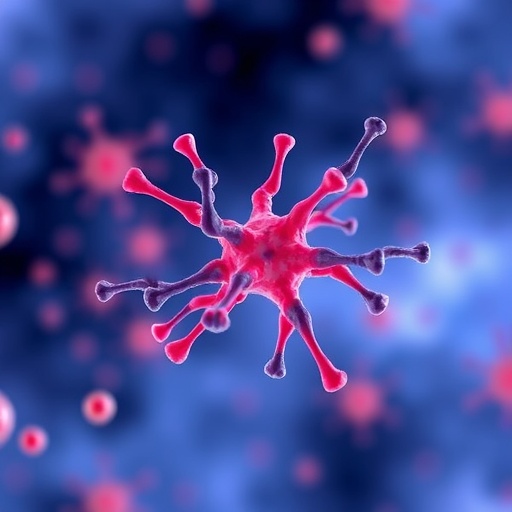In an innovative study published in Clinical Proteomics, researchers have made significant strides in understanding the complex landscape of multiple myeloma through novel proteomic characterization. Multiple myeloma, a malignancy of plasma cells in the bone marrow, presents unique challenges in terms of prognosis and treatment strategies. The investigation sheds light on fluid components found within the bone marrow interstitial space, exploring how they correlate with the dynamics of coagulation pathways—a key factor in the pathology of many hematological malignancies.
The study highlights the critical need for a deeper ontological understanding of the bone marrow microenvironment. The bone marrow interstitial fluid, often overlooked, serves as a reservoir of biomarkers that may provide insights into tumor behavior and patient outcomes. By employing cutting-edge proteomic techniques, the researchers have unveiled intricate networks of proteins that play pivotal roles not only in the survival of malignant cells but also in facilitating the progression of the disease.
Through advanced mass spectrometry, the authors identified a multitude of proteins within the interstitial fluid, revealing connections to various coagulation pathways. This groundbreaking discovery could redefine how researchers approach multiple myeloma therapy. Understanding the proteomic landscape opens the door to tailored therapeutic strategies aimed at disrupting these pathways, potentially leading to improved patient prognoses.
High-throughput analysis allowed for the quantification of proteins that have been previously linked to coagulation dysregulation, which is common in multiple myeloma patients. The study particularly emphasizes the role of fibrinogen elevation, which serves as both a potential biomarker for disease progression and a contributor to thrombotic complications experienced by patients. Elevated fibrinogen levels may reflect increased activity of coagulation pathways that often correlate with worse outcomes.
The implications of these findings resonate beyond mere biomarker identification. The interplay between coagulation and tumor biology could indicate a novel therapeutic avenue, as interventions that target coagulation pathways might also exhibit anti-tumor effects. This dual utility emphasizes the need for a holistic approach in treating not just the cancer, but also the associated thrombotic risks, thus potentially improving patient quality of life.
Another significant outcome of the research involves the potential for these proteins to serve in predictive models for patient prognosis. By integrating the proteomic data with clinical parameters, the authors suggest that healthcare practitioners can develop more reliable prognostic tools. Such tools could aid in stratifying patients not only based on traditional metrics but also through this newly elucidated proteomic profile.
This study stands at the intersection of cancer research and proteomics, highlighting how multi-dimensional approaches enhance understanding of complex diseases. With ongoing advancements in proteomic technologies, researchers are better equipped than ever to explore the myriad biochemical influences that govern cancer behavior within its microenvironment.
The collaboration among multidisciplinary teams of scientists and clinicians further illustrates the importance of a comprehensive approach to biomedical research. By combining insights from basic science, clinical practice, and advanced technologies, significant leaps toward understanding multifaceted diseases like multiple myeloma can be achieved. This study exemplifies how collaborative efforts can illuminate previously obscure pathways and relationships.
Moving forward, the team envisions that similar proteomic frameworks could be employed to analyze other hematological cancers, broadening the scope of this pioneering work. This research lays the groundwork for a promising new frontier where proteomic profiling can lead to universally applicable breakthroughs in cancer treatment strategies, enhancing the potential for personalized medicine.
In conclusion, the investigation conducted by Cutler and colleagues not only contributes to the corpus of knowledge surrounding multiple myeloma but also underscores the vital importance of integrating proteomics into cancer research. As we venture into an era where personalized treatment regimens become more prevalent, studies such as this will be paramount in guiding clinical decisions and improving overall patient care.
Ultimately, this work does not merely represent advancements in proteomic methodology but serves as a clarion call to the scientific community. It urges the continued exploration and validation of biomarkers in the clinical setting, advocating for a thorough understanding of how they can be harnessed to change the narrative of diseases, like multiple myeloma, that have long challenged oncologists and patients alike. As our comprehension of these intricate biological networks deepens, the path to innovative and effective treatments may soon become clearer.
The promise of these findings holds the potential to transform aspects of multiple myeloma prognosis and therapy, addressing a multidisciplinary audience keen on harnessing proteomics for clinical advantage. Future research, inspired by these discoveries, will likely delve deeper into mechanistic studies aimed at deciphering the exact roles these identified proteins play in tumor growth and the tumor microenvironment, ultimately charting new strategies in combatting hematological malignancies.
As this area of research continues to mature, the impacts on clinical practices and patient outcomes will undoubtedly strengthen the importance of biomarkers derived from proteomic analyses. The growing synergy between proteomics and clinical applications is an exciting frontier in oncology, fostering the hope for more effective and targeted therapeutic approaches against one of the most challenging blood cancers today.
Subject of Research: Proteomic characterization of multiple myeloma bone marrow interstitial fluid and its connection to coagulation pathways.
Article Title: Novel proteomic characterization of multiple myeloma bone marrow interstitial fluid links prognosis to coagulation pathways.
Article References: Cutler, S., Trottier, A.M., Liwski, R. et al. Novel proteomic characterization of multiple myeloma bone marrow interstitial fluid links prognosis to coagulation pathways. Clin Proteom 22, 40 (2025). https://doi.org/10.1186/s12014-025-09560-6
Image Credits: AI Generated
DOI: 10.1186/s12014-025-09560-6
Keywords: multiple myeloma, proteomics, bone marrow, interstitial fluid, coagulation pathways, prognosis.




